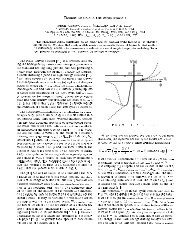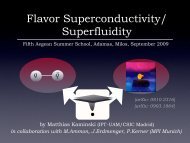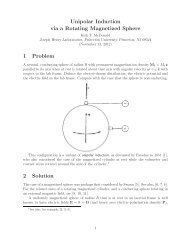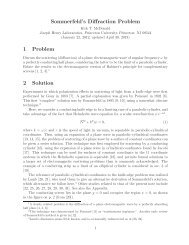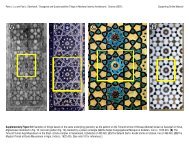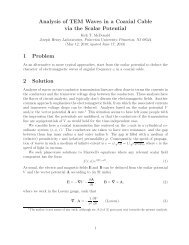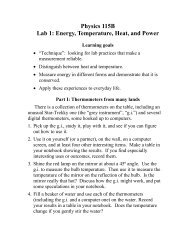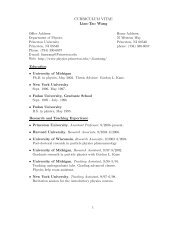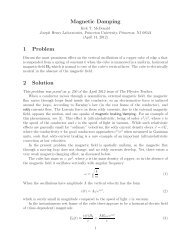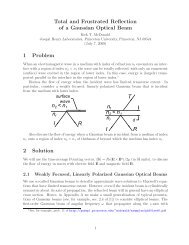Polarization Dependence of Emissivity - Physics Department ...
Polarization Dependence of Emissivity - Physics Department ...
Polarization Dependence of Emissivity - Physics Department ...
Create successful ePaper yourself
Turn your PDF publications into a flip-book with our unique Google optimized e-Paper software.
<strong>Polarization</strong> <strong>Dependence</strong> <strong>of</strong> <strong>Emissivity</strong><br />
David J. Strozzi<br />
<strong>Department</strong> <strong>of</strong> <strong>Physics</strong>, Massachusetts Institute <strong>of</strong> Technology, Cambridge, MA 02139<br />
Kirk T. McDonald<br />
Joseph Henry Laboratories, Princeton University, Princeton, NJ 08544<br />
(April 3, 2000)<br />
1 Problem<br />
Deduce the emissive power <strong>of</strong> radiation <strong>of</strong> frequency ν into vacuum at angle θ to the normal<br />
to the surface <strong>of</strong> a good conductor at temperature T , for polarization both parallel and<br />
perpendicular to the plane <strong>of</strong> emission.<br />
2 Solution<br />
The solution is adapted from ref. [1] (see also [2]), and finds application in the calibration <strong>of</strong><br />
the polarization dependence <strong>of</strong> detectors for cosmic microwave background radiation [3, 4].<br />
Recall Kirchh<strong>of</strong>f’s law <strong>of</strong> heat radiation (as clarified by Planck [5]) that<br />
P ν<br />
A ν<br />
= K(ν, T ) = hν3 /c 2<br />
e hν/kT − 1 , (1)<br />
where P ν is the emissive power per unit area per unit frequency interval (emissivity) and<br />
∣ E<br />
A ν = 1 − R = 1 −<br />
0r ∣∣∣<br />
2<br />
∣<br />
E 0i<br />
is the absorption coefficient (0 ≤ A ν ≤ 1), c is the speed <strong>of</strong> light, h is Plank’s constant and<br />
k is Boltzmann’s constant. Also recall the Fresnel equations <strong>of</strong> reflection that<br />
(2)<br />
E 0r<br />
E 0i<br />
∣ ∣∣∣⊥<br />
= sin(θ t − θ i )<br />
sin(θ t + θ i ) ,<br />
E 0r<br />
E 0i<br />
∣ ∣∣∣‖<br />
= tan(θ t − θ i )<br />
tan(θ t + θ i ) , (3)<br />
where i, r, and t label the incident, reflected, and transmitted waves, respectively.<br />
The solution is based on the fact that eq. (1) holds separately for each polarization <strong>of</strong><br />
the emitted radiation, and is also independent <strong>of</strong> the angle <strong>of</strong> the radiation. This result is<br />
implicit in Planck’s derivation [5] <strong>of</strong> Kirchh<strong>of</strong>f’s law <strong>of</strong> radiation, and is stated explicitly in<br />
[6]. That law describes the thermodynamic equilibrium <strong>of</strong> radiation emitted and absorbed<br />
throughout a volume. The emissivity P v and the absorption coefficient A ν can depend on<br />
the polarization <strong>of</strong> the radiation and on the angle <strong>of</strong> the radiation, but the definitions <strong>of</strong><br />
polarization parallel and perpendicular to a plane <strong>of</strong> emission, and <strong>of</strong> angle relative to the<br />
normal to a surface element, are local, while the energy conservation relation P ν = A ν K(ν, T )<br />
is global. A “ray” <strong>of</strong> radiation whose polarization can be described as parallel to the plane <strong>of</strong><br />
emission is, in general, a mixture <strong>of</strong> parallel and perpendicular polarization from the point<br />
<strong>of</strong> view <strong>of</strong> the absorption process. Similarly, the angles <strong>of</strong> emission and absorption <strong>of</strong> a ray<br />
1
are different in general. Thus, the concepts <strong>of</strong> parallel and perpendicular polarization and<br />
<strong>of</strong> the angle <strong>of</strong> the radiation are not well defined after integrating over the entire volume.<br />
Thermodynamic equilibrium can exist only if a single spectral intensity function K(ν, T )<br />
holds independent <strong>of</strong> polarization and <strong>of</strong> angle.<br />
All that remains is to evaluate the reflection coefficients R ⊥ and R ‖ for the two polarizations<br />
at a vacuum-metal interface. These are well known [1, 2, 7], but we derive them for<br />
completeness.<br />
To use the Fresnel equations (3), we need expressions for sin θ t and cos θ t . The boundary<br />
condition that the phase <strong>of</strong> the wave be continuous across the vacuum-metal interface leads,<br />
as is well known, to the general form <strong>of</strong> Snell’s law:<br />
k i sin θ i = k t sin θ t , (4)<br />
where k = 2π/λ is the wave number. Then,<br />
cos θ t = √ 1 − k2 i<br />
sin 2 θ<br />
kt<br />
2 i . (5)<br />
To determine the relation between wave numbers k i and k t in vacuum and in the conductor,<br />
we consider a plane wave <strong>of</strong> angular frequency ω = 2πν and complex wave vector<br />
k,<br />
E = E 0 e i(k t·r−ωt) , (6)<br />
which propagates in a conducting medium with dielectric constant ɛ, permeability µ, and<br />
conductivity σ. The wave equation for the electric field in such a medium is (in Gaussian<br />
units)<br />
∇ 2 E − ɛµ ∂ 2 E<br />
c 2 ∂t = 4πµσ ∂E<br />
2 c 2 ∂t , (7)<br />
where c is the speed <strong>of</strong> light. We find the dispersion relation for the wave vector k t on<br />
inserting eq. (6) in eq. (7):<br />
kt 2 = ɛµ ω2<br />
c + i4πσµω . (8)<br />
2 c 2<br />
For a good conductor, the second term <strong>of</strong> eq. (8) is much larger than the first, so we write<br />
where<br />
k t ≈<br />
√ 2πσµω<br />
c<br />
d =<br />
(1 + i) = 1 + i<br />
d<br />
=<br />
2<br />
d(1 − i) , (9)<br />
c<br />
√ 2πσµω<br />
≪ λ (10)<br />
is the frequency-dependent skin depth. Of course, on setting ɛ = 1 = µ and σ = 0 we obtain<br />
expressions that hold in vacuum, where k i = ω/c.<br />
We see that for a good conductor |k t | ≫ k i , so according to eq. (5) we may take cos θ t ≈ 1<br />
to first order <strong>of</strong> accuracy in the small ratio d/λ. Then the first <strong>of</strong> the Fresnel equations<br />
becomes<br />
∣<br />
E 0r ∣∣∣⊥<br />
= cos θ i sin θ t / sin θ i − 1<br />
E 0i cos θ i sin θ t / sin θ i + 1 = (k i/k t ) cos θ i − 1<br />
(k i /k t ) cos θ i + 1 ≈ (πd/λ)(1 − i) cos θ i − 1<br />
(πd/λ)(1 − i) cos θ i + 1 , (11)<br />
2
and the reflection coefficient is approximated by<br />
∣ E<br />
R ⊥ =<br />
0r ∣∣∣<br />
2<br />
∣<br />
E 0i<br />
For the other polarization, we see that<br />
so that<br />
⊥<br />
≈ 1 − 4πd<br />
λ cos θ i = 1 − 2 cos θ i<br />
√ ν<br />
σ . (12)<br />
E 0r<br />
E 0i<br />
∣ ∣∣∣‖<br />
= E 0r<br />
E 0i<br />
∣ ∣∣∣⊥ cos(θ i + θ t )<br />
cos(θ i − θ t ) ≈ E 0r<br />
E 0i<br />
∣ ∣∣∣⊥ cos θ i − (πd/λ)(1 − i) sin 2 θ i<br />
cos θ i + (πd/λ)(1 − i) sin 2 θ i<br />
, (13)<br />
R ‖ ≈ R ⊥<br />
(<br />
1 − 4πd<br />
λ<br />
sin 2 )<br />
θ i<br />
≈ 1 −<br />
cos θ i<br />
4πd = 1 − 2 √ ν<br />
λ cos θ i cos θ i σ . (14)<br />
An expression for R ‖ valid to second order in d/λ has been given in ref. [7]. For θ i near 90 ◦ ,<br />
R ⊥ ≈ 1, but eq. (14) for R ‖ is not accurate. Writing θ i = π/2 − ϑ i with ϑ i ≪ 1, eq. (13)<br />
becomes<br />
∣<br />
E 0r ∣∣∣‖<br />
≈ ϑ i − (πd/λ)(1 − i)<br />
E 0i ϑ i + (πd/λ)(1 − i) , (15)<br />
For θ i = π/2, R ‖ = 1, and R ‖,min = (5 − √ 2)/(5 + √ 2) = 0.58 for ϑ i = 2 √ 2πd/λ.<br />
Finally, combining eqs. (1), (2), (12) and (14) we have<br />
and<br />
P ν⊥ ≈<br />
4πd cos θ<br />
λ 3<br />
hν<br />
e hν/kT − 1 , P ν‖ ≈ 4πd<br />
λ 3 cos θ<br />
hν<br />
e hν/kT − 1 , (16)<br />
P ν⊥<br />
P ν‖<br />
= cos 2 θ (17)<br />
for the emissivities at angle θ such that cos θ ≫ d/λ.<br />
The conductivity σ that appears in eq. (16) can be taken as the dc conductivity so long<br />
as the wavelength exceeds 10 µm [1]. If in addition hν ≪ kT , then eq. (16) can be written<br />
P ν⊥ ≈<br />
4πd kT cos θ<br />
λ 3 , P ν‖ ≈<br />
4πd kT<br />
λ 3 cos θ , (18)<br />
in terms <strong>of</strong> the skin depth d.<br />
We would like to thank Matt Hedman, Chris Herzog and Suzanne Staggs for conversations<br />
about this problem.<br />
3 References<br />
[1] M. Born and E. Wolf, Principles <strong>of</strong> Optics, 7th ed., (Cambridge U. Press, Cambridge,<br />
1999), sec. 14.2.<br />
[2] L.D. Landau and E.M. Lifshitz, The Electrodynamics <strong>of</strong> Continuous Media (Pergamon<br />
Press, Oxford, 1960), sec. 67.<br />
3
[3] E.J. Wollack, A measurement <strong>of</strong> the degree scale cosmic background radiation anisotropy<br />
at 27.5, 30.5, and 33.5 GHz, Ph.D. dissertation (Princeton University, 1994), Appendix<br />
C.1.1.<br />
[4] C. Herzog, Calibration <strong>of</strong> a Microwave Telescope, Princeton U. Generals Expt. (Oct.<br />
26, 1999).<br />
[5] M. Planck, The Theory <strong>of</strong> Heat Radiation (Dover Publications, New York, 1991),<br />
chap. II, especially sec. 28.<br />
[6] F. Reif, Fundamentals <strong>of</strong> statistical and thermal physics (McGraw-Hill, New York, 1965),<br />
sec. 9.14.<br />
[7] J.A. Stratton, Electromagnetic Theory (McGraw-Hill, New York, 1941), sec. 9.9.<br />
4



